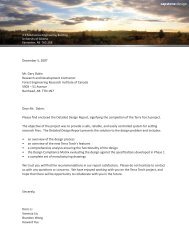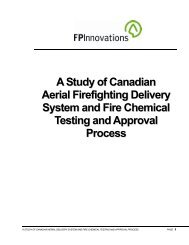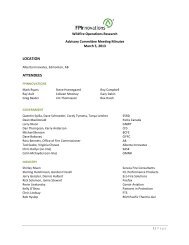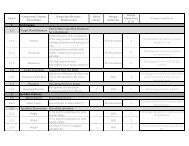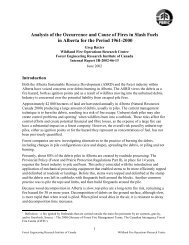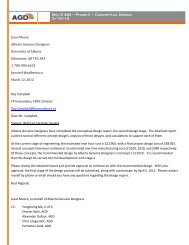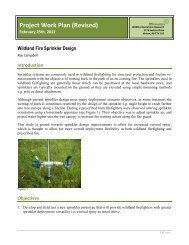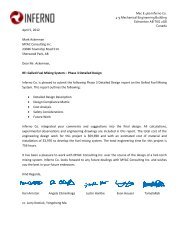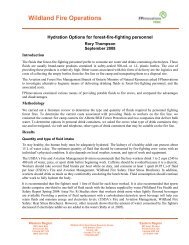Report: Chisholm wildfire entrapment investigation - FPInnovations ...
Report: Chisholm wildfire entrapment investigation - FPInnovations ...
Report: Chisholm wildfire entrapment investigation - FPInnovations ...
You also want an ePaper? Increase the reach of your titles
YUMPU automatically turns print PDFs into web optimized ePapers that Google loves.
when leadership requirements and experience levels are adequate. Similarly, policy allows for British Columbia’s<br />
Sustained Action Crews to be reconfigured into Initial Attack crews and this policy also needs to be reviewed.<br />
All persons involved in this <strong>entrapment</strong> used their personal protective equipment as required. British<br />
Columbia has an Operational Safe Work Standard that details the requirements for their personnel to be<br />
issued fire shelters (Appendix V). The shelter deployment on LWF-063-2001 was a precautionary measure<br />
taken to offer firefighters some protection from radiant heat and blowing embers. The fire shelters showed<br />
no sign of damage, defects or exposure to intense heat, although this is not to imply that their deployment was<br />
unwarranted.<br />
13. Fire management agencies should review their <strong>entrapment</strong> avoidance training programs.<br />
The two fire management agencies involved have a number of significantly different policies, procedures and<br />
regulations (Occupational Health and Safety and Workers Compensation Board) that govern safe work<br />
practices. Notable differences, for example, include: practices surrounding danger trees; LACES (Alberta)<br />
versus LCES (British Columbia); the issuance of Fire Weather Advisories and Fire Behaviour Warnings;<br />
and, the mandatory use of different PPE such as fire shelters, steel toe boots, and side impact hard hats.<br />
14. The different policies, procedures and regulations that are associated with the safe work practices of various fire<br />
management agencies need to be discussed prior to the deployment of imported resources, and such discussion<br />
should take place at the Command level. Discussions at the CIFFC level need to explore the possibility of moving these<br />
differences towards a set of national standards for wildland firefighters.<br />
The strategies and tactics chosen by the Crew Boss and Sector Boss, that were approved by the Division and<br />
Line Boss, were not appropriate given the fuel type and expected fire behaviour.<br />
15. Fire management agencies should review their training programs and where required develop reference material to<br />
illustrate appropriate firefighting strategies and tactics under different environmental conditions. Moreover, a national<br />
approach to address these issues for the 16 fuel types in the Canadian Forest Fire Danger Rating System (Forestry<br />
Canada Fire Danger Group, 1992) would be beneficial.<br />
The message issued by the Fire Boss at the Strategy Team meeting the evening prior to the <strong>entrapment</strong><br />
stressed the severity of the burning conditions anticipated and that the safety of firefighters was paramount.<br />
He stated that "Tomorrow’s fire behaviour will be very extreme and violent, every firefighter must have two<br />
feet in the black and there will not be “green” between any firefighter and the fire. No fire is worth the life of<br />
a firefighter and if anyone feels at all uncomfortable with the situation they should pull themselves off. Use<br />
your LACES.” This safety message was not received at the crew level.<br />
General safety messages were issued from the line down without full analysis of the situation at hand and<br />
without field audits to ensure that crews had implemented what was required on the ground. "Two feet in<br />
the black" couldn’t be applied universally due to dangerous snags and trees, and Safety Zone and Escape<br />
Route requirements change depending on the fire behaviour conditions forecast.<br />
16. Command and Line staff must concern themselves with environmental conditions and potential hazards on the line by<br />
way of ground reconnaissance missions. It is imperative that Command and Line staff have a responsibility to monitor<br />
compliance with the application of LCES/LACES on the ground daily, especially when out-of-province or inexperienced<br />
crews are being used, to ensure that appropriate safe work practices are being implemented. The responsibility for this<br />
will hopefully be clarified when Alberta adopts the Incident Command System (ICS), in which the Safety Officer is<br />
responsible for the identification of fireline hazards.<br />
17. Fire management agencies should review and refine procedures for the issuance of safety messages and establish<br />
procedures to confirm receipt of the same at the crew level. Agencies should standardize the audit process, including<br />
Page 20 of 61



